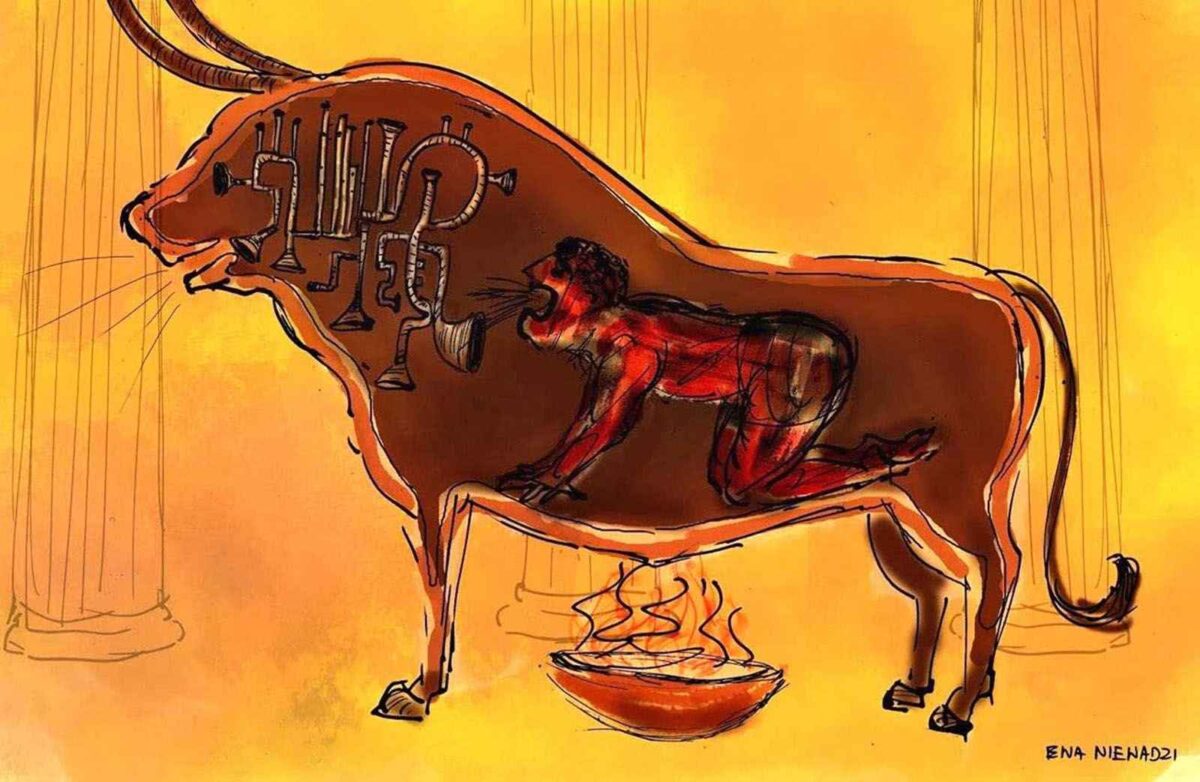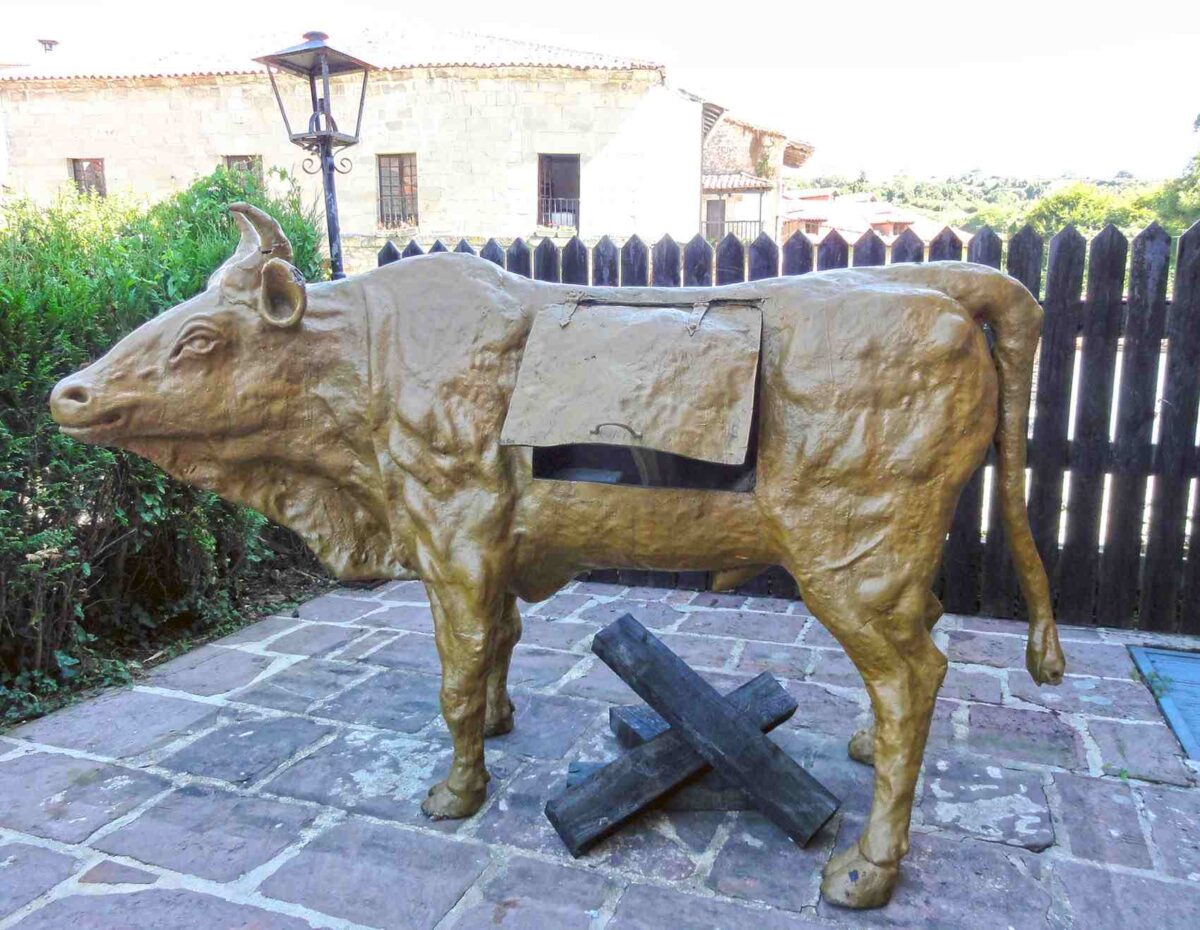Was there a more terrifying symbol of cruelty than the brazen bull? The Brazen Bull, a gruesome invention of ancient Greece, stands as a chilling testament to humanity's capacity for inflicting suffering.
This horrifying device, also known as the Bronze Bull, Sicilian Bull, or Bull of Phalaris, was a hollow bronze sculpture of a bull, with a door to put the victim in, designed for the execution of criminals and political opponents. The unfortunate soul was locked inside, and a fire was lit beneath the bull, roasting the victim alive.
The story of the Brazen Bull is inextricably linked with Phalaris, the tyrant of Akragas (modern-day Agrigento, Sicily). According to historical accounts, Phalaris commissioned Perilaus of Athens to design a new and exceptionally cruel method of execution. The resulting creation was a monument to barbarity, a hollow brass statue designed to amplify the screams of its victims, transforming them into the sounds of a bellowing bull.
| Attribute | Details |
|---|---|
| Name | Brazen Bull (also known as the Bronze Bull, Sicilian Bull, Bull of Phalaris) |
| Origin | Akragas (Agrigento), Sicily, Ancient Greece |
| Inventor | Perilaus of Athens (accounts vary between Perilaus and Perillos) |
| Commissioned By | Phalaris, Tyrant of Akragas |
| Purpose | Torture and execution |
| Description | Hollow bronze statue of a bull with a door, a fire would be made under the sculpture. |
| Victims | Criminals, political opponents |
| Notable Use | During the reign of Phalaris, other historical sources suggest usage in medieval times as a symbol of tyranny. |
| Legacy | Symbol of extreme cruelty and a testament to the dark side of human history. |
| Associated Figures | Phalaris, Perilaus/Perillos, Diodorus Siculus |
| Authenticity | Disputed by some historians, with debate on the historical accuracy of the torture device |
| Reference Website | Britannica |
The device's construction was ingeniously brutal. The bull was crafted from bronze, a material known for its durability and ability to conduct heat. The interior was a hollow chamber where the condemned were imprisoned. A fire was then set beneath the bull, slowly roasting the victim alive. But the true horror of the Brazen Bull lay in its innovative design: the head of the bull was fitted with a system of tubes and stops. This sophisticated sound system amplified the screams of the dying, converting them into the terrifying bellowing of a bull.
The invention of the Brazen Bull is attributed to Perilaus of Athens. Historical accounts suggest that Perilaus, perhaps seeking to curry favor with Phalaris, presented the bull as a novel method of execution. According to legend, the first person to be "tested" in the Brazen Bull was Perilaus himself. Phalaris, upon seeing the device and hearing its intended use, reportedly ordered that Perilaus be the first victim. The story serves as a cautionary tale about the dangers of cruelty and the potential for those who design such instruments to become victims of their own creations.
The primary source for the Brazen Bull is Diodorus Siculus, the story is recounted in his Bibliotheca Historica. Diodorus's account has been challenged by some historians, casting doubts on its authenticity. Some scholars argue that the Brazen Bull may be a product of embellished storytelling. The lack of concrete archaeological evidence, alongside the sensational nature of the device, has led to skepticism about its actual use. However, it is impossible to completely discount the device given the documented cruelty of rulers like Phalaris.
The method of using the Brazen Bull was simple, yet horrific. The condemned was placed inside the hollow bronze statue through a door, which was then sealed. A fire was lit beneath the bull, slowly heating the metal. The victim, trapped in the confined space, would be subjected to intense heat, causing excruciating pain. As the victim screamed in agony, their cries would be channeled through the system of tubes in the bull's head, creating the illusion of a bellowing bull.
The Brazen Bull was not merely a torture device; it was also a macabre spectacle. The public was invited to witness the executions, which further amplified the device's symbolic power. The screams of the victims, transformed into the sounds of a raging bull, would have been designed to terrorize the populace and solidify Phalaris's position as a ruthless ruler. The gruesome theatricality of the executions would have served as a form of psychological warfare, deterring dissent and discouraging any thoughts of rebellion.
The legacy of the Brazen Bull extends far beyond ancient Greece. The device became a potent symbol of tyranny and cruelty in subsequent centuries. It was frequently referenced in literature and art, serving as a warning against the abuse of power. The story of the Brazen Bull is a stark reminder of the darkest aspects of human nature, illustrating the depths to which individuals can sink when they wield absolute authority. The chilling image of the bronze bull continues to resonate, reminding us of the importance of justice, human rights, and the imperative to resist oppression.
While the historical existence of the Brazen Bull remains debated, its influence is undeniable. The device continues to fascinate and horrify, prompting discussions about the nature of torture, the psychology of violence, and the dangers of unchecked power. Its enduring presence in our collective memory ensures that we never forget the lessons of the past.
The Brazen Bull's association with Phalaris, known for his alleged acts of cannibalism and other atrocities, further solidifies its place in the annals of cruelty. The fact that Phalaris supposedly turned the tables on its inventor, Perilaus, by using the bull on him, adds an extra layer of tragic irony to the narrative. This story is meant to demonstrate the cyclical nature of violence, and the ways in which those who perpetrate it can also become its victims.
The story of the Brazen Bull also highlights the ingenuity of ancient craftsmen. The construction of the bull, with its complex sound system, would have required significant technical skill. This stands in stark contrast to the device's purpose, serving as a reminder that even artistic and engineering prowess can be employed for the most inhumane ends.
The enduring popularity of the Brazen Bull in popular culture reflects its continued relevance. The device has been referenced in various forms of media, from literature to film. This ongoing fascination suggests that the story of the Brazen Bull continues to resonate with audiences, providing a means for exploring themes of power, justice, and the human capacity for both creation and destruction.
The Brazen Bull isn't a singular device in history. Similar methods of execution and torture were employed in different parts of the world, emphasizing that the propensity for inflicting cruelty is a sadly universal trait. The existence of such devices, across different cultures and time periods, underscores the need for vigilance in protecting human rights and fighting against all forms of oppression.
The Brazen Bull, as a concept, persists because it perfectly encapsulates the fear of being utterly helpless, of being trapped and at the mercy of someone else's will. It is a visceral symbol of suffering, a warning about the darkest sides of human nature. Whether it was a real historical device or a legend that grew, its image and story will likely continue to haunt the human imagination for centuries to come.
One thing is certain; the legacy of the Brazen Bull is one of cautionary tales and reminders. It is a reminder of the extremes people are capable of, and of the importance of compassion, justice, and the unwavering protection of human dignity. Its story is a timeless warning. The details are debated, but the message remains clear, and the chilling image of the bronze bull still resonates through the ages, a stark symbol of the perils of tyranny.
The details surrounding the Brazen Bull highlight several key aspects of its time:
- Political Power: The device embodies the absolute power wielded by tyrants like Phalaris.
- Technological Advancement: The intricate design of the bull showcases the advanced metalworking of the era, even if it was used for evil ends.
- Psychological Warfare: The executions served as a form of public intimidation and control.



Detail Author:
- Name : Concepcion Volkman I
- Email : nola71@yahoo.com
- Birthdate : 1983-06-23
- Address : 730 Mohr Parkway Apt. 524 Port Katarinafort, AK 42759
- Phone : +1 (463) 268-8940
- Company : Willms PLC
- Job : Fire Investigator
- Bio : Ut optio est itaque nihil minima. Nam enim esse ut ea nostrum temporibus similique minima. Autem provident sunt esse debitis voluptas.